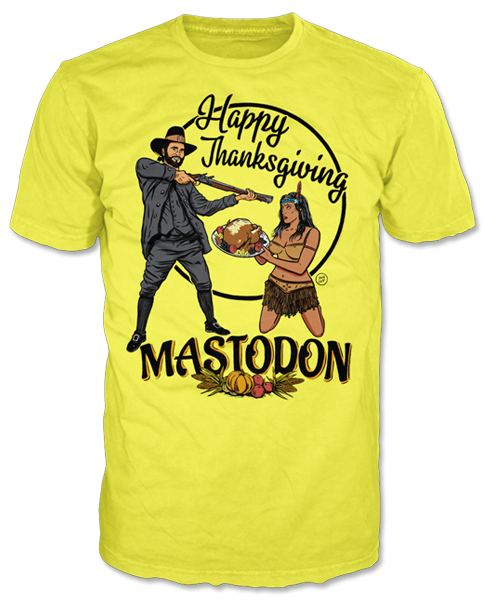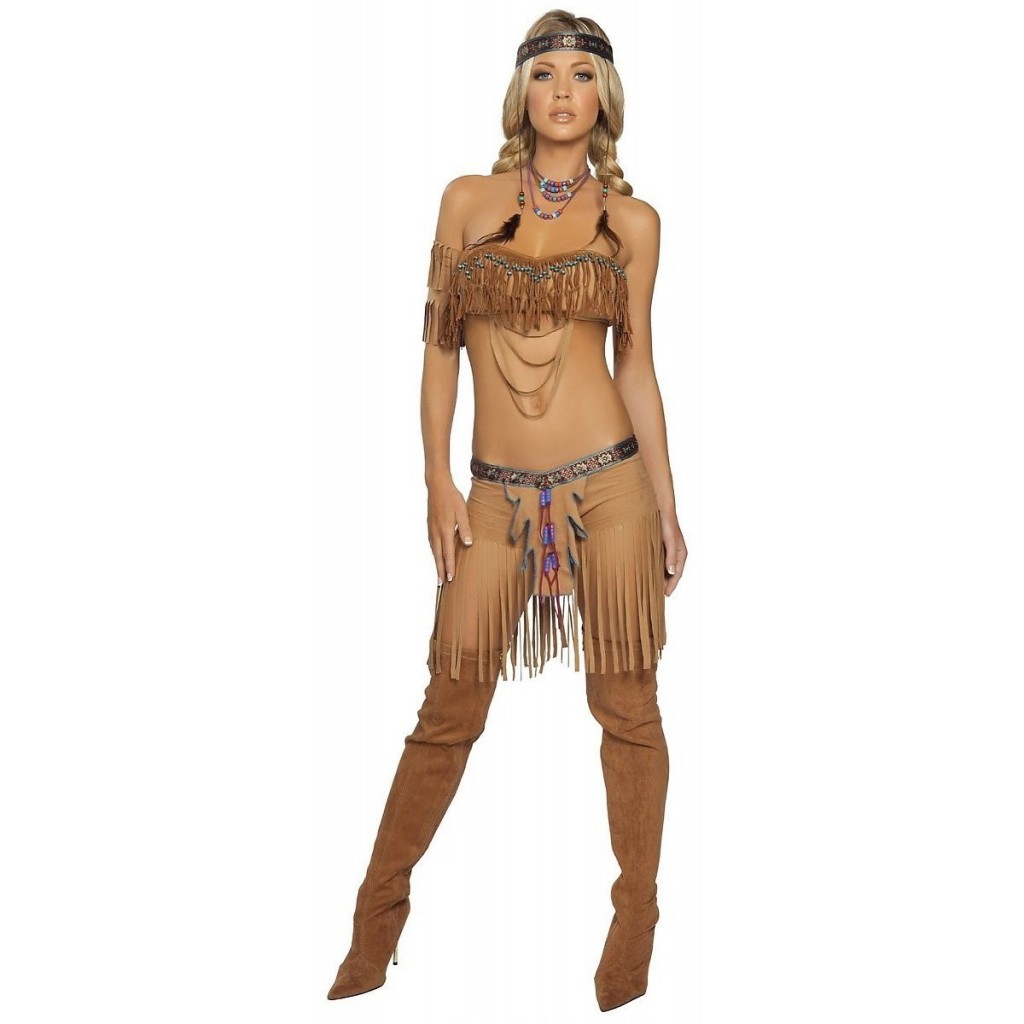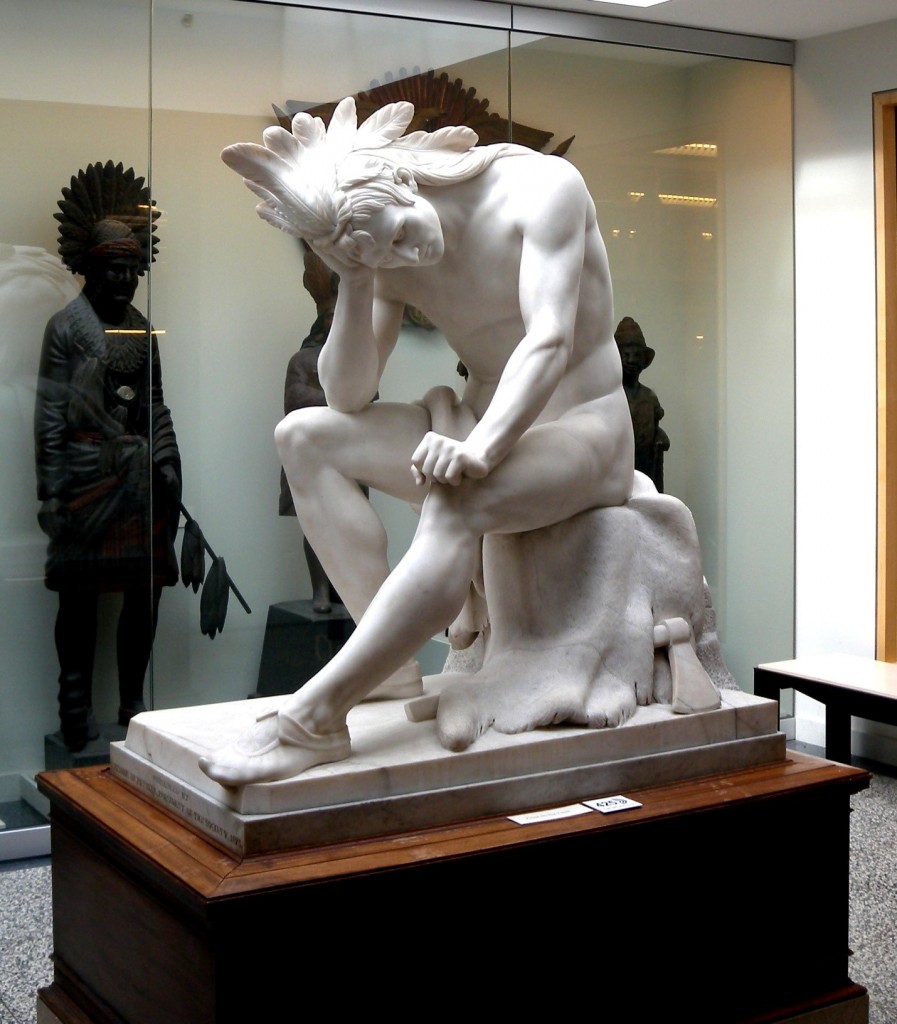In “celebration” of Thanksgiving, American heavy metal band Mastodon (pictured above) released a controversial limited-edition t-shirt [fig. 1]. The T-shirt’s violent imagery and seemingly celebratory attitude towards genocidal atrocities polarized Mastodon fans and fans of heavy metal more generally. In response, the band issued a statement of Facebook clarifying their position and intent.
Regarding our thanks giving (sic) shirt, whether you choose to believe or not, the American Indians were massacred by the white settlers who became the Americans we are today. this (sic) shirt represents this atrocity and celebrating in the face of this atrocity is chilling. We may have a sick sense of humor, but we are far from being “Racist” as some of you who might not get it are calling us.1
Ignoring the fact that sarcasm and irony are not necessarily the most appropriate means of addressing issues of racism and systematic acculturation, both positive and negative responses to the shirt largely ignored the question of gender and sexualized violence.2

Figure 1: Mastodon Special Edition “Thanksgiving” Shirt, 2013.
The feather in her hair, the short grass skirt, and the buckskin bustier highlight the victim’s “otherness” as well as her sexual appeal. Her knelt position and her willingness to offer food are rebutted by the settler’s loaded gun and strange smile that is not overtly menacing, fierce, or smarmy. It appears as if no judgment is being made about the settler, but the female victim’s race and sexuality are purposefully constructed for the viewer. This may help to explain why people failed to see the irony intended by the designer and the band. The visual tropes employed by the designer to represent indigenous identity are so bound within the racist and misogynistic attitudes they seek to address that any reading of the image as something other than a perpetuation of these attitudes is difficult to take seriously. And yet, critics of the shirt responded almost exclusively to issues of race and violence without taking seriously the implication of female sexuality and male-oriented forms of power.3
The designer – perhaps unknowingly – has tapped into a long history of representations of Native Americans in American painting. Specifically, the shirt evokes John Vanderlyn’s The Death of Jane McRea, an 1804 painting recounting, in lurid visual form, the death of a young Tory sympathizer who was allegedly murdered by a group of American Indians contracted by British Lieutenant General John Burgoyne while escorting her to a British camp in 1777 [fig. 2].

Figure 2: John Vanderlyn, The Death of Jane McCrea. Oil on Canvas, 1804. Wadsworth Atheneum, Hartford, Connecticut.
The incident galvanized the growing Patriot cause, and became part of American folklore.4 The painting depicts two Native warriors, one of whom holds back McCrea’s hair while the other prepares to remove her scalp (the rumored method of execution, although this has been debated, resulting in the exhumation of McCrea’s body several times). Vanderlyn employs standard representations of male power derived from classical sources. According to Art Historian Wayne Craven, Vanderlyn specifically references the Borghese Gladiator. He writes, “Vanderlyn used two views of the Gladiator and made only minor changes in doing so…the Gladiator had long been recognized as one of the most celebrated accomplishments of antiquity.”5
While Vanderlyn’s use of such a well-known source as the model for his Indians may be reflective of his desire to display his works in Europe, the comparison between Indians and Gladiators also reflects hegemonic attitudes towards Native American masculinity. The sculptural quality of the two male bodies, contrasted with the frail and captive McCrea, reflects an attraction to, and revulsion of, Indian male physical power. Although the “savagery” of the two captors is made readily apparent, the gladiatorial source implies that there is an exciting, almost revelatory, potential in the raw physicality of the two captors.
Herein lies the most problematic aspect of both The Death of Jane McCrea and the Mastodon Thanksgiving t-shirt: McCrea’s captors are simultaneously exotic, frightening, and physically dominant. Their sculpted bodies draw out the tension between sex and violence, exacerbated by McCrea’s nearly exposed breast. While the t-shirt attempts to invert the roles of the settler and the native – the native is cast as the helpless captive and the settler functions as the aggressor – the t-shirt maintains the same gender dynamic, and evokes the hypersexualized female body, a trope that plays itself out in popular consciousness in a variety of other ways, particularly during Halloween and other costumed events. [fig. 3] The particular brand of exotic sexuality apparent in the t-shirt repeats hegemonic attitudes towards indigenous femininity, while also failing to accurately address the genocidal atrocities it seeks to elucidate.

Figure 3. Roma Costume Company, “Sexy Cherokee Warrior Indian Girl Costume.”
As a subculture that purposefully situates itself outside of the accepted social norms of the state, the myriad thematic elements employed by metal bands reflect an anti-authoritarian sensibility. From extreme acts such as the church arsons in Norway in the early nineties to the seemingly banal obsession with gore and death, heavy metal is a subculture in which one’s identity is inextricably linked to one’s position vis-à-vis the state. It is not surprising, then, that issues of Native American sovereignty serve as an occasional source of lyrical inspiration. Pointing the finger at the agents of the state responsible for the systematic eradication of traditional lifeways and enforcement of the reservation system becomes symbolic of larger issues of state control and arrogance. Most notably, “Indians,” by New York-based thrash metal legends Anthrax, recounts the plight of indigenous peoples living on reservations.
Forced out/brave and mighty/stolen land/they can’t fight it/hold on/to pride and tradition/even they know how much their lives are really missin’/we’re dissin’ them/on reservations/a hopeless situation.
Despite lead singer Joey Belladonna’s claims of partial Native American ancestry, the music video for the song is riddled with outmoded and romantic representations of native peoples.6 Belladonna’s massive feather headdress, the projected images of portrait photographs and other images of ethnographic interest, and the instrumentation, harmony, and rhythm of the song’s intro evoke standard images of indigenous culture that reify the tradition/modernity binary that is endemic to popular imaginations of Native American life.
Like the Mastodon t-shirt, this perspective on native culture is indebted to representations of indigenous people from classic tropes in American art. Most notably, the sentiment express by Anthrax echoes Thomas Crawford’s 1856 sculpture The Dying Chief Contemplating the Progress of Civilization. [fig. 4] The title of the work is totally unambiguous about the intent of its formal composition. The chief stares pensively, presumably as he performs the pondering suggested by the title. His classical body is adorned with a feather headdress, and his tomahawk is laid safely on the ground next to his feet. He is both helpless and accepting of the unassailable march of progress. The Dying Chief is a material evocation of the purported timelessness of Indian lifeways. It additionally conflates these lifeways with nature, thus maintaining the nature/culture binary that is paramount to the reification of narratives of progress and civilization.

Figure 4: Thomas Crawford, The Dying Chief Contemplating the Progress of Civilization, White Marble and Wood, 1856. New York Historical Society, New York, NY.
While the Dying Chief and “Indians” exhibit some sensitivity to issues of genocide and coercive assimilation, this attitude is representative of a decidedly different form of male power. Unlike the evocation of male violence and sexual dominance present in the shirt and Jane McCrea, the statue and the Anthrax song reflect more paternalistic forms of male power and control. Indigenous peoples, whose traditions and lifeways are intimately connected to nature, are powerless to stop the totalizing force of modernity. This narrative echoes anthropologist Sherry Ortner’s claims regarding the relationship between nature and culture, and masculinity and femininity. She writes,
The formulation I would like to defend and elaborate on, then, is that women are seen ‘merely’ as being closer to nature than men. That is, culture (still equated more or less unambiguously with men) recognizes that woman is an active participant in its special processes, but sees her as being, as the same time, more rooted in, or having more direct connection with, nature.7
The persistent juxtaposition of “traditional” indigenous culture and the destructive capacity of modernity and global capital mirror the asymmetrical relationship between nature/femininity and culture/masculinity described by Ortner. That is, mainstream American culture is sympathetic towards – and sensitive to – the plight of American Indian culture and lifeways. Perhaps even going so far as to acknowledge the important contributions American Indian communities have made to mainstream American culture. However, such sympathy is a product of male-oriented paternalism that conceives of Euro-American lifeways as inevitably more “cultured” than their indigenous counterparts, for whom the relationship between human, animal, and supernatural beings is an integral component of local systems of authority, power, and cosmology.
Moreover, the paternalist mentality directly contributed to the establishment of Indian schools, the reservation system, and other institutional forms of forced assimilation. Richard Henry Pratt, the head of the Carlisle Indian Industrial School, famously stated that the mission of any Indian school should be to “kill the Indian, and save the man inside.” Such institutions sought to untether Native peoples from the seemingly “primitive” aspects of indigenous systems of thought and being that, for men like Pratt and others, were a hindrance to participation in modern forms of industrial labor and democratic society.8
While heavy metal T-shirts, Halloween costumes, and nineteenth century American art operate within distinct “object cultures,”9 the use of particular visual expressions of Native American life indeed perdures. While the historical and material specificity associated with each individual object reflects shifting systems of production, use, circulation, and value, all rely on narratives of cultural decline, victimhood, and normative forms of male power. When examined collectively, the ways in which Native American culture is framed by the dominant culture begin to take on transhistorical scope. That is to say that the remarkable consistency with which Native American lifeways are contextualized for non-indigenous consumers and viewers reflects both the specific historical and material conditions in which a particular object circulates, as well as the larger-scale dynamics of indigenous/non-indigenous relations.
Chris Patrello
PhD student in the Program in Visual and Cultural Studies at The University of Rochester
- Facebook post on the band’s official page ↩
- Lyrically, Mastodon songs tend to gravitate towards the hypermasculine. In particular, Leviathan (2004) is a concept album inspired by Melville’s Moby Dick. Focusing specific attention on themes such as the battle between “man and nature,” conquest, and bloodshed, the lyrical content of the album can be safely described as masculine ↩
- MetalSucks, a popular heavy metal blog, recaps the responses, both favorable and negative, to the shirt. Largely ignoring the question of gender or male power, responses to the shirt (as presented by the now defunct link on their site) focus particular attention on the question of violence and genocide. Tellingly, the final paragraph provides readers with a link to the shirt in the Mastodon online merch store, and notes that the shirt also comes in “girls’ sizes.” The distinction between women and girls is not intentional, but at least implicitly reveals the male-centric nature of heavy metal as a subculture ↩
- Despite her personal political leanings, Revolutionary propaganda used the event to underscore the inability of the British to provide the protection they promised to those who remained loyal ↩
- Wayne Craven. “The Grand Manner in Early Nineteenth-Century American Painting: Borrowings from Antiquity, the Renaissance, and the Baroque.” American Art Journal 11 (April 1979): 15 ↩
- In an interview with a Polish music blog (http://www.papatomski.com/2012/05/joey-belladonna-we-have-something.html) Belladonna describes his Native ancestry as something about which he is only sentimental. He also claims that his mother is Iroquois, but provides no other specifics regarding tribal affiliation, etc. I don’t doubt his claims, but would like to suggest that his own sentimental association with hereditary traditions is similarly imbricated in this complex network of romanticism and paternalism ↩
- Sherry Ortner, “Is Female to Male as Nature Is to Culture?” Feminist Studies 1, no. 2 (5-31): 12 ↩
- Elizabeth Hutchinson’s The Indian Craze: Primitivism, Modernism, and Transculturation in American Art, 1890 – 1915 discusses the artistic production at Indian Schools in great detail. For more information, please see Chapter 2: “The White Man’s Indian Art,” 51-90 ↩
- Bill Brown, “Objects, Others, and Us (The Refabrication of Things)” Critical Inquiry 36, no. 2 (Winter 2010): 188. Brown describes object cultures as the network of objects through which a given culture “constitutes itself.” There is a dialectical relationship between human and non-human actors; one in which objects mediate relationships while at the same time the relationship between objects is simultaneously mediated by human actors ↩

